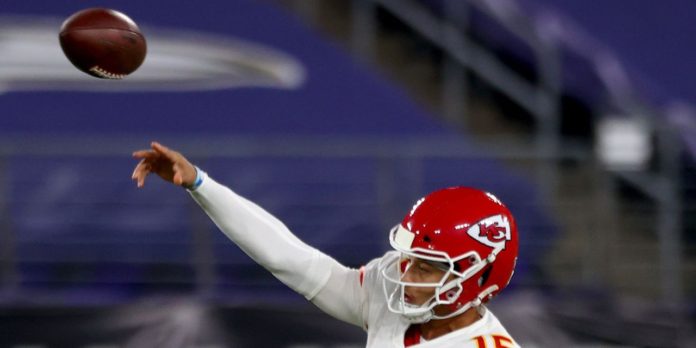
For years, the University of Nebraska physics professor Tim Gay—no relation, at least I’m pretty sure—would observe the long, spiraling flight of an expertly-thrown football pass and find it, well, confusing.
Why did a thrown football behave the way it did? Like many football fans—Gay was also a former player, a tackle at perennial gridiron powerhouse Caltech—he admired the beauty of a well-spiraled pass, especially as depicted in slow-motion on those classic, thunderously-narrated NFL Films.
“Warren Moon would throw this long bomb, and it would just come down like it was nailed to this wire,” Gay said.
The physicist in Gay was perplexed. The start of a football pass exhibits the properties of “angular momentum”—once launched, it spins away, nose upward, maintaining much of its rotation, but then, after reaching its apex, it falls to earth (and hopefully, into the hands of a wide receiver) nose down, still spinning, still symmetrical.
To Gay, this flight pattern didn’t add up. Physics told him that the ball, at a certain point in its trajectory, should start wobbling and tumbling, counter-clockwise. Gravity alone couldn’t explain why a pass could begin as a beautiful spiral and also finish as a beautiful spiral.
Something else had to be going on.
The riddle became, to use Gay’s word, an “obsession.” The Husker prof already owned a measure of notoriety on the Lincoln, Neb., campus for his game-day appearances on the scoreboard at Memorial Stadium, where he explained the dynamics of punts and the collision force of linemen. (Prof. Gay’s fame was memorably chronicled in The Wall Street Journal in 2002 by Jonathan Eig.) Gay even wrote a book called “The Physics of Football,” with a foreword by an old prep school classmate from Phillips Academy Andover named Bill Belichick.
But the spiraling pass question continued to torment him, even on family vacations.
“While my family is cavorting and sunning themselves, I was sitting in a dark room in a log cabin in a La-Z-Boy, with a bottle of Maker’s Mark and a book on aerodynamics, trying to figure out what the hell was going on,” Gay told me.
Richard Price, an MIT professor and the former editor of the American Journal of Physics, recalled a conversation with Gay in which the latter vented his frustration.
“Tim’s the go-to guy on football physics,” Price said. “He started complaining about the fact that there was no good explanation for why a football’s symmetry axis more or less is always tangent to its path.”
Eventually, Gay turned to Price and an old Caltech football teammate, William C. “Willy” Moss, who works at the Lawrence Livermore National Laboratory in Livermore, California.
“Three minds are better than one,” Gay said. “We kind of all figured it out together.”
The result is an apparent breakthrough in sports physics, and a paper, “The Paradox of the Tight Spiral Pass in American Football: A Simple Resolution,” recently published in the American Journal of Physics. In it, Gay, Price and Moss explain how a series of events collaborate to create a spiraling football pass.
“We have shown that the paradox is simply resolved by focusing on the gyroscopic precession driven by the torque that results from the ball’s nonzero angle of attack and by the interaction of that torque with the ball’s angular momentum,” the paper concludes.
Got it? Yeah, me neither.
Today’s column should come with a red light and a warning sign: SPORTSWRITER DOING PHYSICS. I should probably be wearing a helmet. Please bear with me.
“It acts like a gyroscope,” Gay told me, helpfully.
He continued. A well-thrown football pass spins off like a gyroscope, full of momentum, Gay said, and it should continue to spin at the same angle until it falls, end over end, like a duck. What Gay and his colleagues concluded was that torque (produced by air molecules) creates “gyroscopic precession”—a nudge that pushes the ball to finish its trajectory as a spinning beauty.
And gravity? “All that gravity does is to make it go in a parabola,” said Gay.
“It’s a conspiracy of gravity, gyroscopics and wind force,” said Moss. “Those three conspire to make a football do what it does.”
“Physicists get interested in stuff that bores other people,” Price explained. “When you combine torque with the gyroscopic effect of the angular momentum, the two work together, so that in an average sense, the spin axis is very close to tangent to the path.”
In other words, a “perfect” spiral. Still, Price maintains there’s no such thing as a “perfect” spiral, that even the most ideally-thrown passes have detectable wobbles. He recalled watching YouTube videos of current NFL quarterback Patrick Mahomes: “He’s just unreal, and one of the shots was of the football traveling toward the camera…I could count the number of spins, and I could count the rate of wobble. They agreed perfectly with the numbers we had in our paper.”
“I [jokingly] wrote to my colleagues: ‘He must have read the paper.’”
Could any of the conclusions be used by quarterbacks to become better throwing passers—you know, using an optimal arm launch angle and spin rate on the ball?
“Potentially, yes,” Gay said. Still, he cautioned: “It would not be a big effect. I don’t think this is going to in any way revolutionize the game of football. It might help a little bit.”
For Gay, it is a satisfying conclusion to a riddle which consumed him for decades. What’s more, it doesn’t diminish the skill of any quarterback legend—or the mesmerizing beauty of a well-thrown pass.
“Throwing a tight spiral pass 80 yards is a non-trivial athletic achievement,” said Gay.
“It’s like a grand jeté in ballet, or an NBA player going up and seeming to defy gravity,” said Price. “When we understand how it is done…it doesn’t make it less elegant.”
Share Your Thoughts
What do you think of the physicists’ explanation for why a football spiral moves the way it does? Join the discussion.
Write to Jason Gay at Jason.Gay@wsj.com
Copyright ©2020 Dow Jones & Company, Inc. All Rights Reserved. 87990cbe856818d5eddac44c7b1cdeb8








